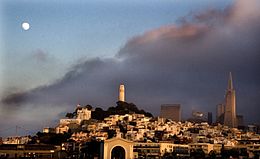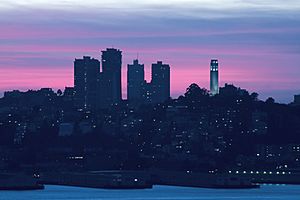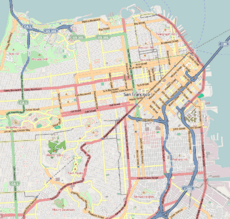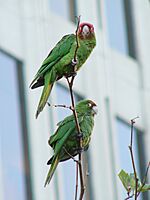Telegraph Hill, San Francisco facts for kids
Quick facts for kids
Telegraph Hill
|
|
|---|---|

Telegraph Hill from San Francisco Bay
|
|
| Country | |
| State | |
| City-county | San Francisco |
| Area | |
| • Total | 0.215 sq mi (0.56 km2) |
| • Land | 0.215 sq mi (0.56 km2) |
| Population
(2008)
|
|
| • Total | 8,177 |
| • Density | 38,055/sq mi (14,693/km2) |
| ZIP Code |
94133, 94111
|
| Area codes | 415/628 |
| Reference #: | 91 |
Telegraph Hill is a famous hill and neighborhood in San Francisco, California. It stands about 285 ft (87 m) tall. It is one of San Francisco's 44 hills and one of its original "Seven Hills."
Contents
Exploring Telegraph Hill's Location
Telegraph Hill is located in the northeastern part of San Francisco. It sits near the water, making it a great spot for views.
Neighborhood Borders
The Telegraph Hill neighborhood has clear boundaries.
- To the south, it's bordered by Vallejo Street.
- Sansome Street is its eastern edge.
- Francisco Street marks its northern side.
- To the west, you'll find Powell Street and Columbus Avenue.
This western area also overlaps with the North Beach neighborhood.
The History of Telegraph Hill
Telegraph Hill has a long and interesting past. It was first named Loma Alta, meaning "High Hill," by the Spaniards. Early San Franciscans called it Goat Hill because goats grazed there. Many Irish immigrants later chose it as their home.
Early Burial Ground
From 1825 to 1847, a part of the hill was used as a burial ground. It was for non-Catholic sailors from other countries. This area was between Sansome and Battery, Broadway and Vallejo streets.
How Telegraph Hill Got Its Name
The hill's name comes from a special signaling system.
- In September 1849, a semaphore was built on the hill. It looked like a windmill.
- This device signaled to the city what kind of ships were entering the Golden Gate.
- It had a pole with two arms that could move into different shapes. Each shape meant something specific, like "steamer" or "sailing boat."
- People used this information to guess what goods were coming. This helped merchants and financiers make smart business choices.
One famous story tells how well-known these signals became. During a play, an actor held his arms up and asked, "Oh God, what does this mean?" Someone in the audience shouted, "Sidewheel steamer!" Everyone laughed.

Quarrying Rocks for Ships
Sailing ships brought goods to San Francisco. But when they left, they often needed heavy rocks called ballast to stay stable. These rocks were dug out from the bay side of Telegraph Hill. You can still see the exposed rock from this quarrying today. A large landslide happened here in 2007, causing some damage.
The First Telegraph Station
In September 1853, the first telegraph in California was set up on the hill. This new technology replaced the old semaphore system. This is how the hill officially got its name, "Telegraph Hill." This "Marine Telegraph Station" was destroyed by a storm in 1870.
Pioneer Park and Coit Tower
- In 1876, George Hearst bought the land where the telegraph station stood.
- He gave it to the city, saying it should be called Pioneer Park.
- From 1932 to 1933, Coit Tower was built on this very spot.
- Telegraph Hill is now a California Historical Landmark #91. A bronze plaque inside Coit Tower marks the original signal station's location.
A Hub for Artists
In the 1920s, Telegraph Hill became a popular place for poets and bohemian thinkers. They dreamed of making it a West Coast version of New York's Greenwich Village.
Attractions and Features of Telegraph Hill
Telegraph Hill is mostly a quiet neighborhood where people live. It's much calmer than the busy cafes and nightlife of nearby North Beach.
The Filbert Steps
One of its most famous features is the Filbert Street Steps.
- These are about 400 wooden steps that go down the east side of Telegraph Hill.
- The steps pass by beautiful gardens of the houses on the hill.
- They go through the Grace Marchant Garden, which a resident named Grace Marchant started in 1949. Neighbors now take care of it.
- The steps lead down to a part of Filbert Street and a walkway to The Embarcadero.
- Many homes in this area can only be reached by these steps. You can even find fire hydrants and a parking meter along the steps!
The Wild Parrots of Telegraph Hill
Telegraph Hill is also famous for its flock of feral parrots. These are mostly red-masked parakeets. They are descendants of pet parrots that either escaped or were set free.
Parrot Popularity
- The flock became well-known because of a book and a documentary film (2003). Both were called The Wild Parrots of Telegraph Hill.
- These birds, also known as cherry-headed conures, originally came from Peru and Ecuador.
- They have formed a breeding group with help from some residents and volunteers.
- The parrots fly all over the area, including along The Embarcadero and in the Presidio.
Feeding Ban
In 2007, San Francisco passed a rule that stops people from feeding parrots in public places. This rule was supported by Mark Bittner, who had fed the birds for many years and wrote the book about them. Other people who care about nature also supported the ban.
See also
 In Spanish: Telegraph Hill (San Francisco) para niños
In Spanish: Telegraph Hill (San Francisco) para niños



